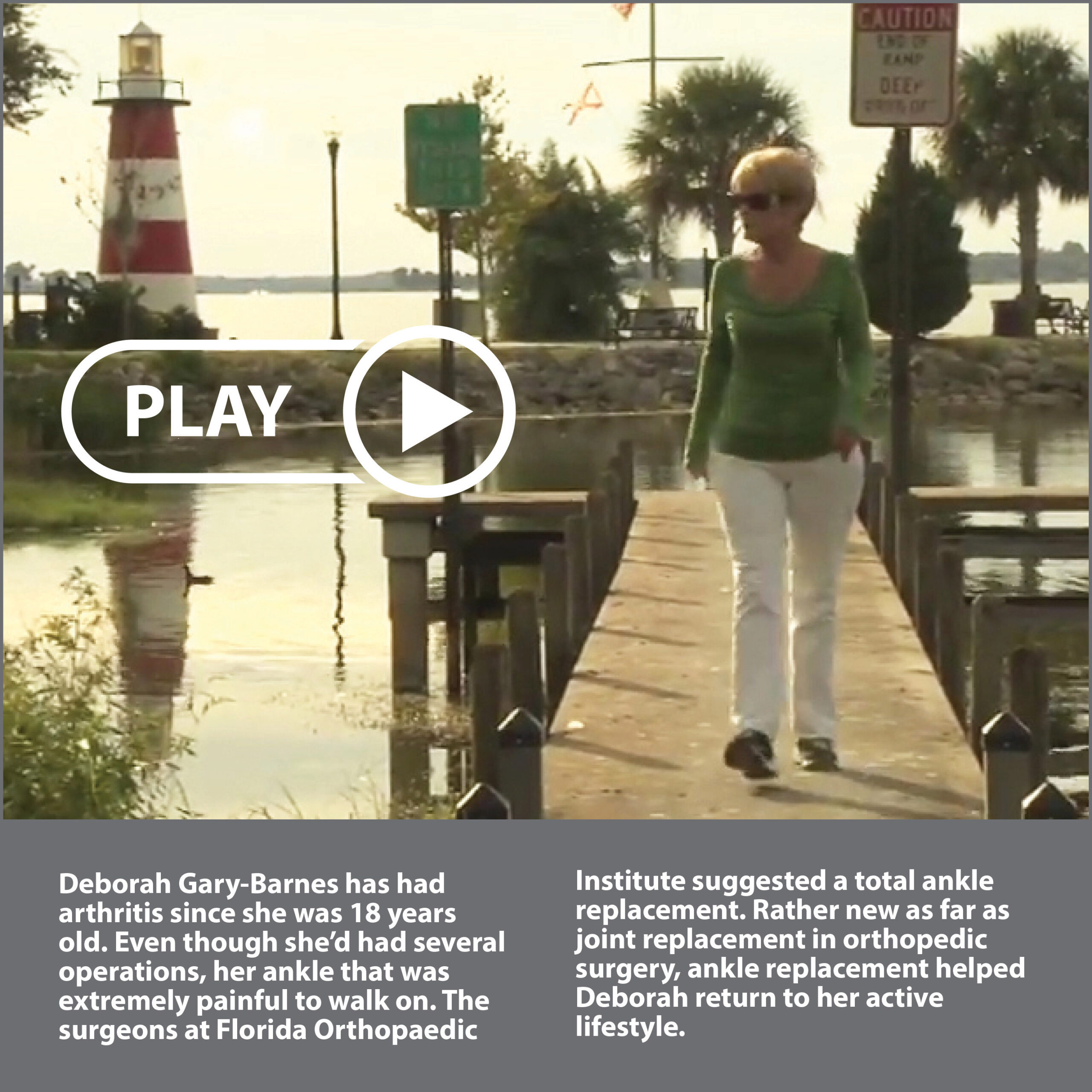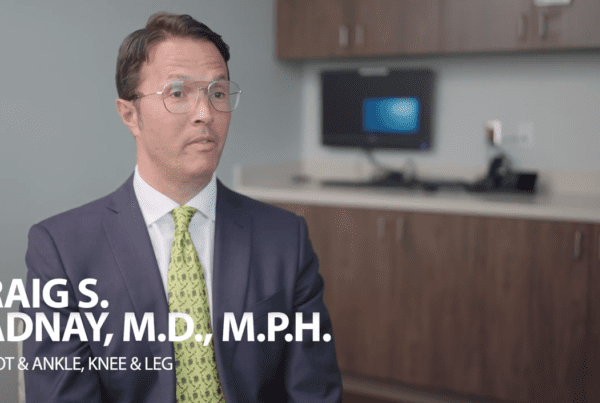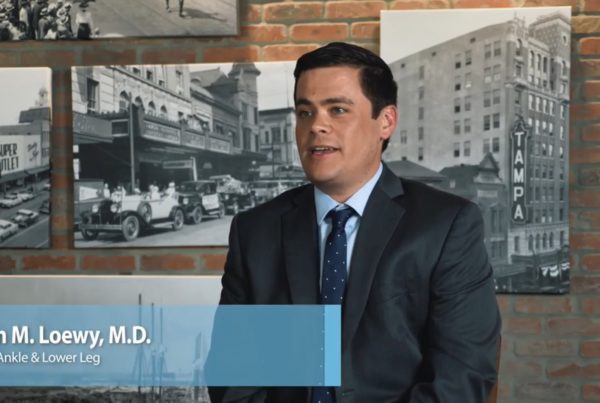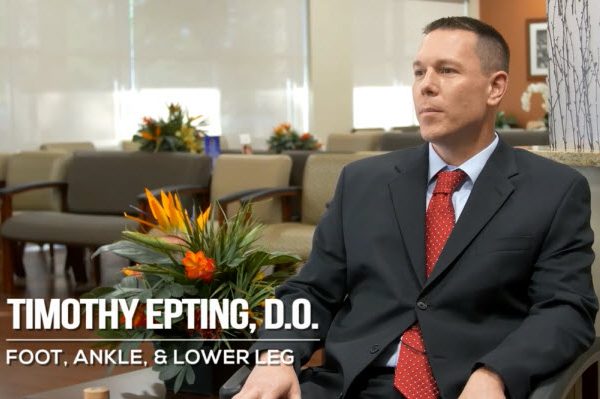Orthopedic Foot and Ankle Specialists
Since 1989, Florida Orthopaedic Institute surgeons have helped thousands of patients get back on their feet with Tampa Bay’s most advanced orthopedic lower extremity service.
Knowledgeable and experienced physicians, therapists, and nurses work together to cover the total spectrum of foot and ankle musculoskeletal care. Our Foot, Ankle & Lower Leg Center includes diagnostic imaging, physical therapy, on-site MRI, and surgical treatments.
Whether tendon, ligament, bone injuries, arthritis, or acute and chronic conditions, Florida Orthopaedic Institute surgeons are fellowship trained and have extensive knowledge in managing all conditions affecting this region of the body. Thankfully, almost all of these problems require conservative management before requiring surgery. Shoe modifications, bracing, physical therapy, and medications are only a part of what is offered.
When surgery is indicated, the operative experience of the surgeon is critical. With the largest combined experience in Florida, the Florida Orthopaedic Institute team has performed tens of thousands of these procedures, including flat foot corrections, ankle and subtalar fusions, midfoot osteotomies, bunion surgery, soft tissue reconstructions, as well as fracture reconstruction.
Is it Time to See a Foot and Ankle Specialist?
There are specific times when it is necessary to see an orthopedic doctor specializing in foot and ankle problems, including:
- The Presence of Underlying Illness – Certain illnesses can contribute to the development of foot and ankle issues. For example, diabetes is known for causing potentially serious foot problems. Specialists help such persons get out in front of any possible concerns before they become significant.
- A Recent Injury – If you were recently injured, seeking a foot and ankle specialist’s opinion is a good idea. They can make sure the healing process is progressing.
- Chronic Foot and Ankle Pain – Chronic (ongoing) pain may indicate that you have a more serious underlying injury or ailment. Lingering discomfort often shows that some problem exists.
- Changes to the Foot or Ankle’s Appearance or Structure – You should visit a specialist if you notice any growth or pain accompanied by new or worsening symptoms such as redness, swelling, bruising, or growths.
The Diagnostic Process
Examinations performed by FOI’s orthopedic foot and ankle specialists typically follow these stages.
- Information Gathering – During the initial stage, your physician will gather your medical history and ask you questions about your overall health, any medications you take, your professional and leisure activities, and if you have any pre-existing physical issues. They might also request that you complete a questionnaire discussing your symptoms, their intensity, and if any movements or actions worsen these problems.
- Physical Exam – Once the information has been obtained, your doctor will perform a thorough exam. Their efforts might include movement tests gauging your foot and ankle’s strength and motion ranges.
- Additional Tests – Sometimes your FOI physician will order blood tests to identify an underlying illness’s presence or diagnostic imaging like X-rays, MRIs (Magnetic Resonance Imaging), or CT scans (Computerized Tomography – also called a CAT scan) to gather internal images of your foot and ankle.
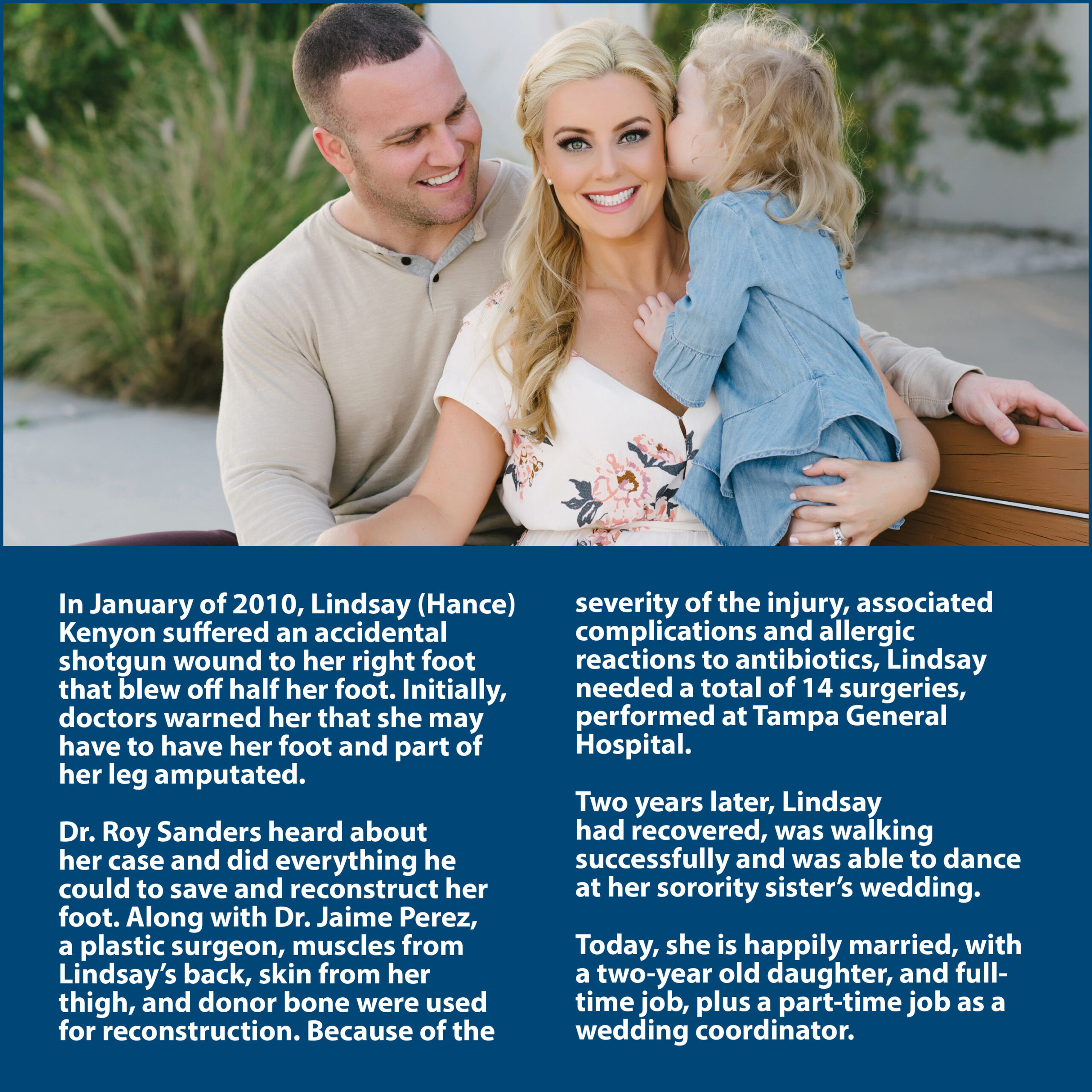
Ankle Fractures (Broken Ankle)
An ankle fracture, also known as a broken ankle, is when one or more of the bones that make up the ankle joint are broken.
Ankle fractures can range from a simple break in one bone to several fractures. The more bones that are broken, the more unstable the ankle becomes.
In many ankle fractures ligaments (that hold the ankle bones and joint in position) are also damaged
Learn more about Ankle FacturesMetatarsalgia
If you participate in activities that involve running and jumping, you can get a condition in which the ball of your foot becomes painful and inflamed. This is called metatarsalgia. It is also caused by foot deformities and shoes that are ill-fitting.
Symptoms of metatarsalgia can include sharp, aching or burning pain in the ball of your foot, pain that worsens when you stand, run, flex your feet or walk, sharp or shooting pain, numbness, or tingling in your toes or the feeling of having a pebble in your shoe.
Learn More about MetatarsalgiaAchilles Calcific Insertional Tendinopathy (ACIT)
Achilles tendinitis occurs when the large tendon that runs down the back of your lower leg (the Achilles tendon), becomes irritated and inflamed.
Achilles Calcific Insertional Tendinopathy (also known as Insertional Achilles Tendinitis) affects the lower portion of the heel, where the tendon attaches to the heel bone. When there is repetitive stress to the tendon, damaged tendon fibers can harden (calcify) and extra bone growth (bone spurs) can be formed causing Achilles Calcific Insertional Tendinopathy.
Learn more about Achilles Calcific Insertional Tendinopathy (ACIT)Intraarticular Calcaneal Fractures
Calcaneal fractures are break of the heel bone (calcaneus). They usually occur from a motor vehicle collision or when a person lands on their feet following a fall from a height.
The heel bone, also known as the calcaneus, is the largest of the tarsal bones and articulates with the cuboid bone anteriorly and the talus bone superiorly. It is responsible for transmitting the majority of the body’s weight from the talus bone to the ground.
Calcaneal fractures are categorized as intra-articular or extra-articular based on the subtalar joint involvement. Most calcaneal fractures are intraarticular (also spelled as intra-articular) resulting from high-energy trauma. Intraarticular fractures involve the posterior talar articular facet of the calcaneus.
Learn more about Intraarticular Calcaneal FracturesAchilles Tendonitis
Achilles tendonitis, also called tendinitis of the heel, is an injury of the Achilles tendon which connects the calf muscle to the heel bone. It is a common injury with more that 200,000 US cases every year. It is spelled as both tendonitis and tendinitis.
The Achilles tendon is the largest tendon in the body, connecting your calf muscles to your heel bone. It is used when you walk, run, climb stairs, jump, and stand on your tip toes. This tendon can withstand great stresses from running and jumping, but it is also prone to tendinitis from overuse and degeneration.
Achilles tendonitis is common in runners and middle-aged people who play sports only on the weekends with key symptoms of heel pain and tenderness.
Learn more about Achilles TendonitisCharcot Joint
Charcot Joint (also known as Charcot foot) is the condition of neuropathic arthropathy or neuropathic osteoarthropathy. It is named after Jean-Martin Charcot, French neurologist and professor of anatomical pathology.
Charcot Foot is progressive degeneration of a weight-bearing foot joint and includes bone destruction, bone resorption, and eventual deformity.
This affects some diabetic patients with loss of sensation (peripheral neuropathy) after several years. Peripheral neuropathy affects the sensory nervous system to the farther, points of the body (like the feet) causing loss of feeling or numbness. Diabetic neuropathy also includes the involuntary nervous system which controls regulation of blood vessels and skin moisture. It can result in increased blood flow to the limb, contributing to swelling and osteoporosis of the bones as the Charcot Joint condition progresses.
Learn more about Charcot JointANKLE FUSION
When the cartilage in the ankle joint becomes damaged from severe arthritis (or from a previous injury or ankle fracture), ankle fusion is used to permanently join the damaged bones, preventing them from rubbing against each another and causing pain.
The ankle joint consists of the shin bones (tibia and fibula) and the ankle bone (talus). Where these bones meet, they are covered by a smooth cartilage lining in the joint that allows you to move your ankle freely. As the cartilage wears, the space in the joint gradually narrows, causing bone-on-bone contact, resulting in pain and stiffness.
For those patients that are not candidates for an ankle replacement, ankle fusions remain the gold standard. Patients can walk without a limp using modern techniques to remove minimal amounts of bone and position the ankle so the joint below moves well.
Learn more about Ankle FusionSPORTS FOOT INJURIES
Any type of athlete is at risk of sustaining a foot or ankle injury or developing an ongoing condition. Injuries to the foot or ankle while participating in sports are common and include plantar fasciitis, stress fractures, ankle sprains, and Achilles tendinitis.
Learn more about the symptoms, risks, and treatments for common foot and ankle sports injuries.
Learn more about SPORTS FOOT INJURIESPLANTAR FASCIITIS
One of the most common causes of heel pain, Plantar Fasciitis is an inflammation of the thick band of tissue (plantar fascia) that runs across the bottom of your foot connecting your heel bone to your toes.
Active men between the ages of 40-70 are most affected. Improper footwear (not enough arch support), running on uneven surfaces, long-distance running, and downhill running are contributing factors. Arch problems in the foot (flat feet or high arches) and sudden weight gain or obesity can be causes.
People with Plantar Fasciitis commonly get a stabbing pain with their first steps in the morning. As they get up and move, the pain normally decreases, sometimes returning after long periods of standing or sitting.
Learn more about the symptoms and treatments of Plantar Fasciitis.
LEARN MORE ABOUT PLANTAR FASCIITISMallet, Hammer & Claw Toes
If your toes are curled under or crooked, you may have hammer, mallet, or claw toe. When the muscles, tendons, or ligaments that surround your toe aren’t balanced, it causes the toes to bend in an odd position.
One of the main causes of hammer, mallet and claw toes is wearing shoes that don’t fit properly or high heels. Tight fitting shoes crowd your toes and force them into a bent position. Then the muscles tighten and shorten.
Mallet, hammer, and claw toes are some of the most common toe problems.
LEARN MORE ABOUT MALLET, HAMMER & CLAW TOESSprained Ankle
Ankle sprains happen when the ligaments that support the ankle stretch beyond their limits and tear. They are a common injury that can occur among people of all ages. Depending upon how much damage there is to the ligaments, ankle sprains can range from mild to severe.
While most minor sprains heal with treatments like rest and ice, be sure to see a doctor if your ankle is very swollen, painful to walk on or if you are having trouble putting weight on it.
To learn more about the causes, symptoms, and treatments for ankle sprains, click below.
Learn more about Sprained AnklesCheilectomy
A Cheilectomy is an operation to remove a bony lump on the top of the main joint of the big toe. Also known as hallux rigidus, this condition is usually caused by arthritis of the great toe.
Cheilectomies are performed because the bony lump is causing pain by pressing on your shoes. It is also used as a treatment for early arthritis of the big toe if the joint is not yet badly affected. Some people have both issues.
LEARN MORE ABOUT CHEILECTOMIESAnkle Arthritis
Unfortunately, this is a rather common problem and requires careful management to maintain motion while minimizing pain. The first line of treatment remains oral medications, but injections are frequently used by the staff to minimize the inflammation within the ankle that causes the pain. When this is not effective, arthroscopy may be used remove irritating tissue.
These minimally invasive procedures are designed to prevent the need for an open procedure. However, when arthritic pain and deformity prevents patients from maintaining a normal lifestyle, either a fusion or an ankle replacement is required.
Total Ankle Replacements
In 1995, the Agility® total ankle prosthesis became available in the U.S. Florida Orthopaedic Institute was the third center in the country to implant this device, with our surgeons involved in design, teaching, and evaluation of the implant. Later that year a European ankle known as the S.T.A.R.® was released, and Florida Orthopaedic surgeons were involved in the first trial of that prosthesis in the U.S.
Since that time, Florida Orthopaedic Institute surgeons (all trained on total ankle replacements) have performed hundreds of replacements. With over 20 years of experience, the foot and ankle surgeons of Florida Orthopaedic Institute remain leaders in the field.
Learn more about Total Ankle ReplacementsNeuromas (Foot)
Neuromas are a thickening of the tissue around a nerve leading to the toes. It is a fairly common problem, with over 200,000 U.S. cases every year and is more common in women than men.
The most common neuroma in the foot is Morton’s neuroma, sometimes referred to as an intermetatarsal neuroma. Morton’s neuroma occurs between the third and fourth toes.
Neuroma can be caused by pressure or injury, such as use of high heels or from running.
Symptoms can include sharp, burning pain, numbness in the ball of the foot or toes, pins and needles or a reduced sensation of touch. Sometimes it can feel like a lump in the sole of the foot, the sensation of walking on a marble, a pebble in a shoe or a fold in a sock.
Learn more about NeuromasPROstep™ Minimally Invasive Surgery For Bunions
Bunions (a misalignment of the bone at the big toe) are one of the most common foot problems. They can be very painful, change the shape of your foot, and limit daily activities.
PROstep™ minimally invasive surgery can significantly reduce your foot pain and get you back to your favorite activities faster than traditional surgery.
CARTIVA® Implant For Big Toe Joint Arthritis
Cartiva™ Synthetic Cartilage Implant (SCI) is a solution for painful arthritis in the big toe. Unlike fusion, which locks the joint in place, Cartiva allows your joint to move how it’s supposed to, so you retain your mobility and range of motion. Don’t let big toe arthritis keep you from an active lifestyle.
ANKLE FRACTURE SURGERY
When one or more of three bones in the ankle joint (tibia, fibula, and talus) break, you have an ankle fracture, also known as a broken ankle.
Broken ankles are usually caused during sports activities when the ankle becomes twisted, turned, or rolled while walking or running. Ankle fractures can also be caused by high-force impacts, such as from an automobile accident or fall.
Not all ankle fractures require surgery. It’s important to get the appropriate surgery by a skilled foot and ankle specialist when they do. Poorly executed or inappropriate surgeries can cause ankle instability, arthritis, require additional corrective surgeries, or even the need for an ankle replacement operation.
Learn more about Ankle Fracture SurgeryLISFRANC INJURIES
A Lisfranc injury is a negative event occurring in the foot’s middle region, where the metatarsal bones of the forefoot connect to the cuneiform bones of the midfoot. When any of the mid-foot structures sustain injuries such as fractures, strains, or tears, Lisfranc injuries can occur. It can involve torn ligaments, broken bones, or a combination of both, and can involve more than one joint.
Some of these events are categorized as simple, meaning they impact only one joint or bone. Others are labeled complex, which means multiple joints or bones are involved.
Lisfranc injuries are caused by a variety of circumstances. Turning or twisting your foot in the wrong direction can result in simple strains or fractures. Trauma from events like automobile accidents falls or when dropping large or heavy objects on your foot usually result in more complicated cases.
Learn more about LISFRANC INJURIESMORTON’S NEUROMA
Morton’s Neuroma is a condition where the tissue around a nerve leading to the toes thickens, causing pain, numbness, and discomfort.
Morton’s Neuroma can feel like a fold in your sock or a pebble in your shoe. There may be a sharp, burning pain or numbness in the toes or the ball of your foot. Some people describe pins and needles, a reduced sensation of touch, a lump in the sole of the foot, or the sensation of walking on a marble.
It can be caused by pressure or injury, such as running or using high heels.
Treatment can include pain medications, self-care, arch supports, footpads, corticosteroid injections, strength exercises, wide-toe shoes, or surgery.
Learn more about Morton's NeuromaARTHROSCOPIC ARTICULAR CARTILAGE REPAIR
Articular cartilage is a smooth, white but tough connective tissue layer that covers the ends of the bones where they join (articulate) with each other within a joint. Without articular cartilage, bone surfaces would rapidly wear away due the friction that occurs when bone rubs against bone.
Normal wear and tear or injury can damage articular cartilage and can be worsened by excess weight.
Articular cartilage can be restored through many procedures done arthroscopically.
Learn more about ARTHROSCOPIC ARTICULAR CARTILAGE REPAIRHAMMER TOE
Hammer toe is a common foot condition in which the toe has an abnormal bend in the middle joint. It causes your toe to bend or curl downward instead of pointing forward. There are more than 200,000 cases in the United States every year. It usually affects the second or third toe.
The affected toes may be hard to move or painful and may develop corns or calluses. Other common symptoms may include physical deformities, joint stiffness, or swelling.
Sometimes, hammer toe may be present at birth but is usually caused by wearing shoes with tight, pointed high heels or narrow toe boxes. It can also develop over time due to arthritis. In most cases, hammer toe is treatable.
Learn more about HAMMER TOEHIGH ANKLE SPRAIN (SYNDESMOSIS LIGAMENT INJURY)
High ankle sprains and syndesmosis injuries are traumatic injuries that affect the distal tibiofibular ligaments. They most commonly occur due to sudden external rotation of the ankle.
The syndesmosis is a slightly movable joint in which the tibia and fibula are joined together by a connective tissue at the ankle.
Symptoms include tenderness over the syndesmosis, which worsens with squeezing the tibia and fibula together at the midcalf.
Ankle injuries are among the most common injuries in sports, with approximately 10% of all severe (acute) injuries treated by physicians.
Learn more about HIGH ANKLE SPRAINSTURF TOE
After artificial turf became more common on football playing fields in America, there was a sharp increase in sprains of the big toe joint. This is where the term “turf toe” originated. It was first described in 1976 by Bowers and Martin at the University of West Virginia. Although associated with football, turf toe can occur in a wide range of sports and activities.
Turf toe is a sprain of the big toe’s main joint – the metatarsophalangeal joint (MTP). This injury can happen when the toe is forcibly bent up into hyperextension, such as when the toe gets stuck flat on the ground or when pushing off into a sprint.
In a survey of pro football players in America, 45% suffered turf toe injuries in their professional careers, with 83% occurring on artificial turf.
Learn more about TURF TOECommon Foot Fractures in Athletes
Common foot fractures in athletes include stress fractures, metatarsal fractures, heel fractures, toe fractures, and Jones fractures. Stress fractures are small cracks in the bone that usually occur due to overuse and repetitive stress. Jones fractures occur in the fifth metatarsal bone, located on the outside of the foot. These types of fractures can also occur from a sudden injury. Treatment for foot fractures typically includes rest, ice, physical therapy, and in some cases, surgery.
Learn more about Common Foot Fractures in AthletesFOOT STRESS FRACTURES
Stress fractures are small cracks or breaks in a bone that is caused by overuse or repetitive stress. In the foot, stress fractures can occur in any bone but are most common in the bones in the midfoot (metatarsals) and the shin bone (tibia). Symptoms of a foot stress fracture include pain, swelling, tenderness in the affected area, and difficulty bearing weight on the affected foot. The treatment for a stress fracture typically involves rest, ice, and elevation to allow the bone to heal. In some cases, a cast or boot may be used to immobilize the foot and allow the bone to heal. Physical therapy may also be prescribed to help strengthen the muscles and improve the foot’s flexibility. In severe cases, surgery may be required to repair the fracture.
Learn more about FOOT STRESS FRACTURESANKLE ARTHROSCOPY
Arthroscopy of the ankle is a minimally invasive surgical procedure that allows a surgeon to visualize, diagnose, and treat problems within the ankle joint. It involves the insertion of a small camera, called an arthroscope, into the ankle joint through small incisions. The arthroscope allows the surgeon to see inside the joint and guide miniature surgical instruments to treat a variety of conditions, including ankle sprains, cartilage damage, bone spurs, ankle impingement and synovitis.
Ankle arthroscopy is generally performed as an outpatient procedure, and recovery time is typically faster than with traditional open surgery.
Learn more ABOUT ANKLE ARTHROSCOPYREVISIONS & REFERRALS
Because of the combined expertise of the Florida Orthopaedic Institute foot and ankle surgeons, as well as their national reputation, patients are referred not only locally, but from all over the country. Many of the referrals are patients with significant post-surgical complications including infections, failed joint replacements, poorly positioned fusions, and non-healed fractures.
These patients are sent to the Center for definitive solutions to their problems, and in most cases our surgeons are able to improve their lives. This ability to solve complex problems and help patients is the driving force behind maintaining the high quality of care offered, and why Florida Orthopaedic Institute is a regional and national referral center.
Specialties include the treatment of:
- Achilles Tendon Injuries.
- Chronic Ankle Ligament Injuries.
- Adult Acquired Flatfoot.
- Bunion Surgery.
- Hammer Toe.
- Morton’s Neuroma.
- Injections.
- Arthritis of the Foot and Ankle.
- Fractures of the Foot and Ankle.
- Total Ankle Arthroplasty (Replacement).

Areas of Focus
- Foot, Ankle & Lower Leg
- Achilles Tendinitis - Achilles Insertional Calcific Tendinopathy (ACIT)
- Achilles Tendon Rupture
- Achilles Tendonitis
- Ankle Fracture Surgery
- Ankle Fractures (Broken Ankle)
- Ankle Fusion Surgery
- Arthroscopic Articular Cartilage Repair
- Arthroscopy Of the Ankle
- Bunions
- Charcot Joint
- Common Foot Fractures in Athletes
- Foot Stress Fractures
- Hallux Rigidus Surgery - Cheilectomy
- Hammer Toe
- High Ankle Sprain (Syndesmosis Ligament Injury)
- Intraarticular Calcaneal Fracture
- Lisfranc Injuries
- Mallet, Hammer & Claw Toes
- Metatarsalgia
- Morton’s Neuroma
- Neuromas (Foot)
- Orthopedic Physician Or A Podiatrist? Definition of a Podiatrist
- Plantar Fasciitis
- Sports Foot Injuries
- Sprained Ankle
- Total Ankle Replacement
- Turf Toe
The following Florida Orthopaedic Institute physicians specialize in Feet, Ankles & Lower Legs:
Common Foot, Ankle & Lower Leg Conditions:
- Accessory Navicular
- Achilles Tendon Injuries
- Ankle Sprains
- Bunions
- Chronic Lateral Ankle Pain
- Claw Toe
- Clubfoot (Talipes Equinovarus)
- Corns
- Diabetic Foot
- Fracture of the Heel Bone (Calcaneus)
- Fracture of the Talus
- Haglund’s Deformity (Retrocalcaneal Bursitis)
- Hammer Toe
- Hallux Rigidus
- High Ankle Sprain (Syndesmosis Ligament Injury)
- Ingrown Toenails
- Jones Fractures
- Lisfranc (Midfoot) Fracture-Dislocation
- Morton’s Neuroma
- Osteochondrial Injuries of the Talus
- Peroneal Tendon Tears
- Peroneal Tendonitis
- Posterior Tibial Tendon Dysfunction (PTTD)
- Rheumatoid Arthritis of the Foot and Ankle
- Sesamoiditis
- Stress Fractures of the Foot and Ankle
Common Foot, Ankle & Leg Procedures:
- Achilles Tendon Lengthening
- Ankle Fracture Surgery
- Ankle Fusion, Transfibular
- Ankle Replacement
- Arthroscopic Articular Cartilage Repair (Ankle)
- Bunionectomy (Chevron Bunionectomy)
- Bunionectomy with Wedge Osteotomy
- Cheilectomy
- Debridement of the Achilles Tendon
- Diagnostic Ankle Arthroscopy
- Endoscopic Plantar Fasciotomy (EPF)
- Excision of Mortons Neuromas
- Excision of Soft Tissue Masses
- First Metatarsal-Phalangeal Joint (MTP) Arthrodesis
- Fixation for Lisfranc Injury
- Kidner Procedure
- Lateral Ankle Ligament Reconstruction
- Midfoot Fusion
- Pulse Dye Laser Wart Removal
- Resection of Haglunds Deformity
- Subtalar Fusion
- Surgery for Achilles Tendon Rupture
- Triple Arthrodesis
- Weil Osteotomy for Claw Toe
Specialties
- AC Joint Injuries
- Achilles Tendinitis - Achilles Insertional Calcific Tendinopathy (ACIT)
- Achilles Tendon Rupture
- Achilles Tendonitis
- ACL Injuries
- Ankle Fracture Surgery
- Ankle Fractures (Broken Ankle)
- Ankle Fusion Surgery
- Anterior Cervical Corpectomy & Discectomy
- Arthroscopic Articular Cartilage Repair
- Arthroscopic Chondroplasty
- Arthroscopic Debridement of the Elbow
- Arthroscopy Of the Ankle
- Articular Cartilage Restoration
- Artificial Disk Replacement (ADR)
- Aspiration of the Olecranon Bursa - Fluid In Elbow
- Atraumatic Shoulder Instability
- Avascular Necrosis (Osteonecrosis)
- Bankart Repair
- Basal Joint Surgery
- Bicep Tendon Tear
- Bicep Tenodesis
- Bone Cement Injection
- Bone Growth Stimulation
- Bone Health Clinic
- Broken Collarbone
- Bunions
- Bursitis of the Shoulder (Subacromial Bursitis)
- Calcific Tendinitis of the Shoulder
- Carpal Tunnel Syndrome
- Charcot Joint
- Chiropractic
- Clavicle Fractures
- Colles’ Fractures (Broken Wrist)
- Common Foot Fractures in Athletes
- Community Outreach
- Cubital Tunnel Syndrome
- De Quervain's Tenosynovitis
- Deep Thigh Bruising
- Degenerative Disk Disease
- Diffuse Idiopathic Skeletal Hyperostosis (DISH)
- Discectomy
- Discitis Treatment & Information
- Dislocated Shoulder
- Dupuytren’s Disease
- Elbow
- Elbow Bursitis
- Elbow Injuries & Inner Elbow Pain in Throwing Athletes
- Epidural Injections for Spinal Pain
- Finger Dislocation
- Flexor Tendonitis
- Foot Stress Fractures
- Foot, Ankle & Lower Leg
- Foraminotomy
- Fractured Fingers
- Fractures Of The Shoulder Blade (Scapula)
- Fractures Of The Tibial Spine
- Functional Nerve Transfers of The Hand
- Ganglion Cysts
- General Orthopedics
- Glenoid Labrum Tear
- Golfer's Elbow
- Groin Strains and Pulls
- Growth Plate Injuries Of The Elbow
- Hallux Rigidus Surgery - Cheilectomy
- Hammer Toe
- Hamstring Injuries
- Hand & Finger Replantation
- Hand & Wrist
- Hand Nerve Decompression
- Hand Skin Grafts
- Hand, Wrist, Elbow & Shoulder
- Heat Injury/Heat Prostration
- High Ankle Sprain (Syndesmosis Ligament Injury)
- Hip & Thigh
- Hip Arthroscopy
- Hip Dislocation
- Hip Flexor Strains
- Hip Fractures
- Hip Hemiarthroplasty
- Hip Impingement Labral Tears
- Hip Muscle Strains
- Hip Pointers and Trochanteric Bursitis
- Hyperextension Injury of the Elbow
- Iliopsoas Tenotomy
- Iliotibial Band Syndrome
- Impingement Syndrome of the Shoulder
- Interlaminar Implants
- Interlaminar Lumbar Instrumental Fusion: ILIF
- Interventional Pain Management
- Interventional Spine
- Intraarticular Calcaneal Fracture
- Joint Replacement
- Knee & Leg
- Kyphoplasty (Balloon Vertebroplasty)
- Kyphosis
- Labral Tears Of The Hip (Acetabular Labrum Tears)
- Laminectomy: Decompression Surgery
- Lateral Collateral Ligament (LCL) Injuries
- Lisfranc Injuries
- Little League Shoulder
- LITTLE LEAGUER'S ELBOW (MEDIAL APOPHYSITIS)
- Lumbar Epidural Steroid Injection
- Lumbar Interbody Fusion (IBF)
- MACI
- Mallet, Hammer & Claw Toes
- Medial Collateral Ligament Injuries
- Meniscus Tears
- Metatarsalgia
- Minimally Invasive Spine Surgery
- Morton’s Neuroma
- Muscle Spasms
- Muscle Strains of The Calf
- Nerve Pain
- Neuromas (Foot)
- Neurosurgery
- Olecranon Stress Fractures
- Orthopaedic Total Wellness
- Orthopaedic Trauma
- Orthopedic Physician Or A Podiatrist? Definition of a Podiatrist
- Osteoarthritis of the Hip
- Osteoporosis
- Outpatient Spine Surgery
- Partial Knee Replacement
- Patellar Fracture
- Pelvic Ring Fractures
- Peripheral Nerve Surgery (Hand) Revision
- Pinched Nerve
- Piriformis Syndrome
- Piriformis Syndrome
- Plantar Fasciitis
- Plastic Surgery
- Podiatry
- Primary Care Sports Medicine
- Quadriceps Tendon Tear
- Radial Tunnel Syndrome (Entrapment of the Radial Nerve)
- Revascularization of the Hand
- Reverse Total Shoulder Replacement
- Rheumatoid Arthritis (RA) of the Shoulder
- Rheumatoid Arthritis Of The Hand
- Robotics
- Rotator Cuff Tears
- Runner's Knee
- Sacroiliac Joint Pain
- Sciatica
- Scoliosis
- Senior Strong
- Shin Splints
- Shoulder
- Shoulder Arthritis
- Shoulder Arthroscopy
- Shoulder Injury: Pain In The Overhead Athlete
- Shoulder Replacement
- Shoulder Separations
- Shoulder Socket Fracture (Glenoid Fracture)
- SLAP Tears & Repairs
- Spinal Fusion
- Spine
- Spondylolisthesis and Spondylolysis
- Sports Foot Injuries
- Sports Hernias (Athletic Pubalgia)
- Sports Medicine
- Sports Wrist and Hand Injuries
- Sprained Ankle
- Sprained Wrist Symptoms and Treatment
- Subacromial Decompression
- Sudden (Acute) Finger, Hand & Wrist Injuries
- Targeted Muscle Reinnervation (TMR)
- Tendon Transfers of The Hand
- Tennis Elbow Treatment
- Thigh Fractures
- Thigh Muscle Strains
- Thumb Ulnar Collateral Ligament Injuries
- Total Ankle Replacement
- Total Hip Arthroplasty
- Total Hip Replacement - Anterior Approach
- Total Knee Replacement Surgery
- Trapezius Strain (Muscle Strain of The Upper Back)
- Traumatic Shoulder Instability
- Tricep Pain & Tendonitis
- Trigger Finger
- Turf Toe
- UCL (Ulnar Collateral Ligament) Injuries
- Ulnar Neuritis
- Valgus Extension Overload
- Vertebroplasty
- WALANT (Wide Awake Local Anesthesia No Tourniquet)
- Whiplash and Whiplash Associated Disorder (WAD)
- Wound Care
- Wrist Arthroscopy
- Wrist Fractures
- Wrist Tendonitis
Services
- Physical Medicine & Rehabilitation
- Physical Therapy
- Primary Care Sports Medicine
- PROMs (Patient-Reported Outcome Measures)
- Same-Day Orthopaedic Appointments Now Available
- Sports Medicine
- Sports-Related Concussion Treatment
- Telehealth Page
- Telemedicine
- Workers' Compensation
- Workers' Compensation Dispensary
- X-Ray
